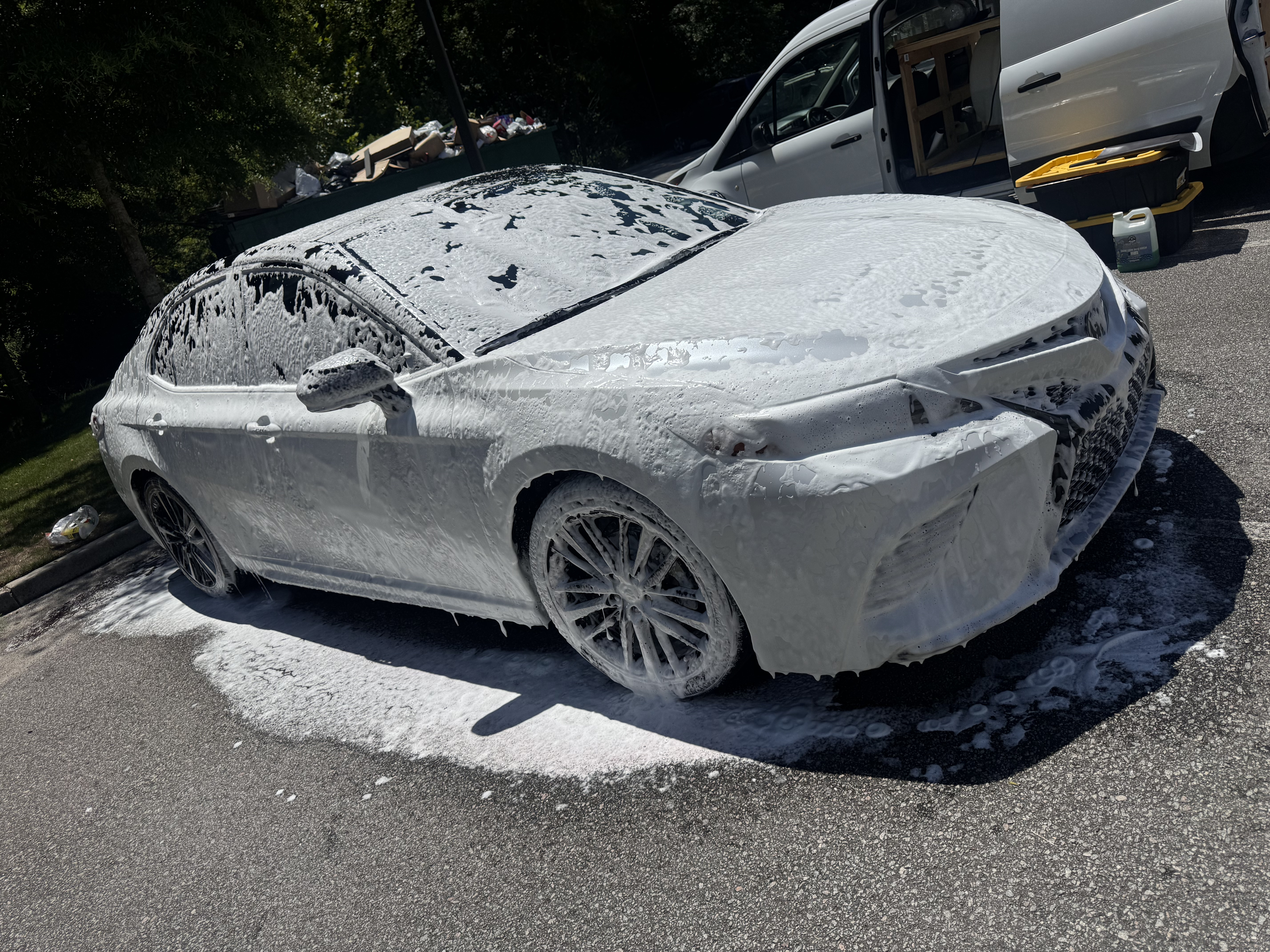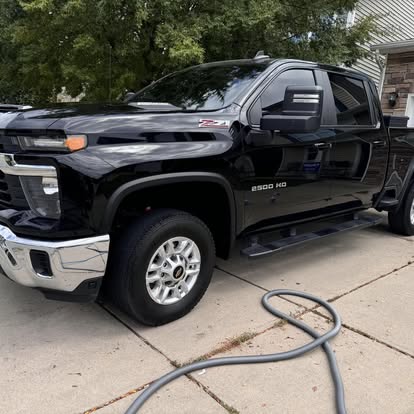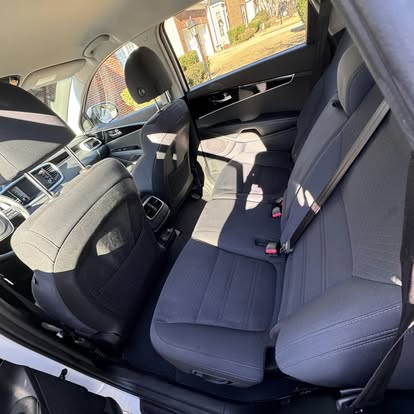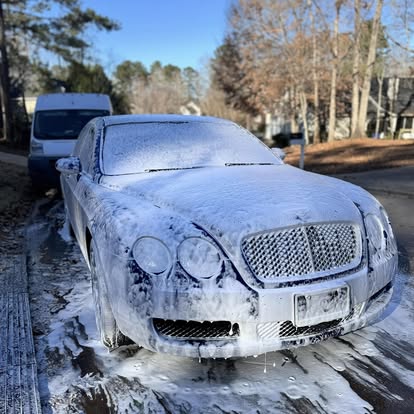Your vehicle communicates when it needs professional attention. Recognizing the signs that your car needs detailing prevents minor issues from becoming permanent damage requiring expensive correction. After detailing thousands of vehicles across Columbia and the Midlands, I've identified clear indicators that separate maintenance-level concerns from urgent professional service needs. This guide helps you spot these warning signs before they cost you money and vehicle value.
Exterior Warning Signs
1. Water No Longer Beads on Paint
What it means: Your protective layer (wax, sealant, or coating) has broken down. Water should bead into tight spheres and roll off surface. When water sheets flat or spots appear, protection is gone.
Why it matters: Unprotected paint in South Carolina's intense UV and heat oxidizes rapidly. Water spots etch into clear coat, contaminants bond more easily, and paint fades faster.
Action needed: Schedule complete detail with fresh protection application. For Columbia vehicles, this typically means quarterly service during summer months when UV exposure breaks down protection fastest.
2. Paint Feels Rough or Gritty
What it means: Bonded contaminants have embedded in clear coat. Run your hand over paint after washing—it should feel glass-smooth. Rough texture indicates tree sap, industrial fallout, pollen residue, or tar bonding to surface.
Why it matters: Bonded contaminants prevent protection from adhering properly and can etch into clear coat over time, especially in heat. Columbia's abundant trees and spring pollen season create significant contamination.
Action needed: Professional clay bar treatment removes bonded contamination. This should be performed before applying any new protection.
3. Visible Swirl Marks or Haziness
What it means: Thousands of fine scratches from improper washing, automated car washes, or low-quality towels have accumulated in clear coat. These show as spiderweb patterns in direct sunlight, especially on dark paint.
Why it matters: Swirl marks reduce gloss and clarity, making paint look dull and aged. They worsen with each improper wash. On black or dark blue vehicles, severe swirling makes paint appear gray or cloudy.
Action needed: [service-paint-correction] removes swirl marks through machine polishing. This should be followed by proper protection and maintenance to prevent recurrence.
4. Faded or Chalky Appearance
What it means: UV oxidation has begun degrading clear coat. Paint loses depth and vibrancy. Light colors develop chalky residue; dark colors fade to lighter shades. Red vehicles fade to pink/orange; black becomes grayish.
Why it matters: Oxidation indicates clear coat breakdown. If caught early, polishing removes oxidized layer and restores color. Severe oxidation may require repainting.
Action needed: Immediate paint correction before oxidation penetrates deeper. Apply maximum UV protection like [service-ceramic-coating] to prevent future damage.
5. Water Spots That Won't Wash Off
What it means: Mineral deposits from hard water have etched into clear coat. Columbia's hard water leaves calcium and mineral deposits that, when baked by sun, permanently bond to paint.
Why it matters: Surface water spots can be removed with specific products, but etched spots require polishing. Left untreated, they become permanent imperfections.
Action needed: Professional water spot removal through polishing, followed by protection to prevent future etching. Address water spots promptly before they become permanent.
Interior Warning Signs
6. Musty or Unpleasant Odors
What it means: Mold, mildew, or bacteria growth in carpet, upholstery, or ventilation system. South Carolina's humidity creates perfect conditions for microbial growth, especially in vehicles without garage parking.
Why it matters: Beyond unpleasant smell, mold poses health risks through poor air quality. Spores spread throughout cabin and worsen over time. Masking odor with air fresheners doesn't eliminate the problem.
Action needed: Professional [service-interior-detailing] with steam cleaning and enzymatic treatment. Severe cases may require ozone treatment. Address promptly before mold spreads.
7. Visible Dirt in Carpet Fibers
What it means: Ground-in dirt has penetrated deep into carpet pile. When you can see dirt in fibers rather than just on surface, regular vacuuming won't remove it.
Why it matters: Embedded dirt acts like sandpaper, wearing carpet fibers. It retains moisture, promoting mold growth. Professional extraction is needed to remove deep contamination.
Action needed: Hot water extraction (steam cleaning) removes embedded dirt and restores carpet appearance. Follow with fabric protector to resist future soiling.
8. Sticky or Grimy Dashboard and Console
What it means: Dust, dirt, and residue from cheap interior products have built up. Surfaces feel sticky or attract dust rapidly. UV damage may also be causing material degradation.
Why it matters: Buildup damages surfaces and looks terrible. Low-quality silicone-based products create greasy film that attracts dirt and can damage electronics. UV degradation causes cracking and fading.
Action needed: Professional interior detailing removes buildup and applies quality UV protectant. Avoid petroleum-based products that cause long-term damage.
9. Cracked or Dried Leather
What it means: Leather has lost moisture and flexibility. South Carolina heat and UV exposure dry leather rapidly. Early stage shows loss of supple feel; advanced stage develops visible cracks.
Why it matters: Leather damage is progressive. Dried leather cracks easily under normal use. Once cracked, leather cannot be fully restored—only replaced at significant cost ($500-3,000+).
Action needed: Immediate professional leather cleaning and conditioning. For Columbia vehicles, monthly conditioning during summer prevents heat damage. Once cracked, only replacement fixes the problem.
10. Foggy Interior Glass That Won't Clean
What it means: Oily film from outgassing plastics has accumulated on interior glass. Dashboard and interior materials release chemicals that deposit on glass, creating persistent haze.
Why it matters: Reduces visibility and safety, especially at night when oncoming headlights create glare. Home glass cleaners often smear this film rather than removing it.
Action needed: Professional glass cleaning with products specifically designed to cut through oily film. Interior surfaces should also be treated to reduce future outgassing.
Additional Warning Signs
Yellowed or Cloudy Headlights
What it means: UV damage has oxidized headlight lenses. This dramatically reduces light output (up to 80%) and fails safety inspections in some states.
Action needed: Professional headlight restoration removes oxidized layer and applies UV protection. Cost: $75-150 vs. $200-800+ for replacement.
Extensive Pet Hair Embedded in Upholstery
What it means: Regular vacuuming can't remove pet hair that's worked deep into carpet and seat fibers.
Action needed: Professional pet hair removal using specialized tools and techniques. This typically adds $50-150 to detail cost but achieves complete removal.
Permanent-Looking Stains
What it means: Spills have set into fabric or carpet. The longer stains remain, the harder removal becomes. Some stains become permanent within hours in heat.
Action needed: Professional stain treatment with appropriate products for stain type. Success rate is highest when addressed quickly.
Bug Splatter or Bird Droppings That Won't Wash Off
What it means: Acidic contaminants have etched into clear coat. In South Carolina heat, etching occurs within 24 hours for bird droppings, faster for bug remains baked by sun.
Action needed: Polishing to remove etching. Prevention through prompt removal (within 24 hours) and quality protection saves money long-term.
Time-Based Indicators
It's Been More Than 3-4 Months Since Last Detail
For Columbia vehicles, quarterly detailing is baseline maintenance. South Carolina's climate accelerates wear—going 6+ months between details allows damage accumulation.
After Pollen Season (Late May)
Columbia's intense pollen season (March-May) deposits acidic yellow powder that etches paint if not properly removed. Post-pollen detail is essential.
Before Selling or Trading In
Professional detail increases resale value $500-2,000. Wait until you see warning signs, and you're repairing damage rather than preventing it.
After Extended Storage
Vehicles stored for months develop moisture, mold, and contamination requiring professional attention before regular use.
Severity Assessment
Needs Attention Soon (1-4 Weeks)
- Water no longer beading
- Light swirling visible
- Slight interior odor
- Dashboard needs cleaning
- 3-4 months since last detail
Needs Attention Now (This Week)
- Rough paint texture
- Moderate swirl marks
- Noticeable musty smell
- Visible carpet dirt
- Dried leather
- 6+ months since last detail
Needs Immediate Professional Intervention
- Paint oxidation/fading
- Severe swirl marks (paint looks gray/cloudy)
- Strong mold/mildew odor
- Cracked leather
- Permanent-looking stains
- Water spot etching
- 12+ months since last detail
Prevention vs. Correction Costs
Prevention Approach
- Quarterly complete detail: $250 × 4 = $1,000/year
- Maintains pristine condition
- No correction needed
- Total annual cost: $1,000
Neglect and Correction Approach
- Annual basic wash: $100/year
- Emergency detail before sale: $500
- Paint correction for oxidation: $600
- Leather conditioning treatment: $200
- Odor elimination: $150
- Total over 3 years: $2,050 with worse overall condition
DIY vs. Professional Assessment
You Can Handle at Home:
- Regular washing (proper technique)
- Basic vacuuming
- Dashboard dusting
- Immediate bird dropping removal
- Interior trash removal
Requires Professional Service:
- Clay bar treatment
- Paint correction
- Carpet extraction
- Leather restoration
- Odor elimination
- Protection application (ceramic coating)
- Headlight restoration
What Happens If You Ignore Warning Signs
Ignored Exterior Issues Lead To:
- Paint oxidation: $500-2,000 to correct or repaint
- Permanent water spot etching: $300-800 to polish out
- Deep swirl marks: $400-1,000 for correction
- Headlight replacement: $200-800 vs. $75-150 for restoration
- Reduced resale value: $500-2,000 loss
Ignored Interior Issues Lead To:
- Mold damage: $500-2,000 for remediation/replacement
- Cracked leather: $500-3,000 for reupholstery
- Permanent stains: $200-1,500 for upholstery replacement
- Dashboard replacement: $200-1,000
- Health issues: Respiratory problems from poor air quality
Taking Action
For Minor Warning Signs
Schedule complete detail within 2-4 weeks. Continue regular maintenance to prevent recurrence.
For Moderate Issues
Book professional detail this week. Discuss specific concerns with detailer for targeted treatment.
For Severe Problems
Immediate professional intervention needed. May require specialized services beyond standard detail—paint correction, leather restoration, or odor elimination.
Maintaining After Professional Detail
Once professional detail addresses warning signs:
Weekly
- Quick rinse (especially during pollen season)
- Remove trash
- Wipe dashboard
Bi-Weekly
- Proper hand wash
- Interior vacuum
- Glass cleaning
Monthly
- Thorough interior cleaning
- Tire dressing
- Leather conditioning (summer months)
Quarterly
- Professional complete detail
- Protection refresh
- Deep cleaning
Listen to Your Vehicle
Your car communicates its needs through visible and tangible warning signs. Water that no longer beads, rough paint texture, mysterious odors, or fading color all signal that professional attention is overdue. Recognizing these indicators early prevents minor issues from becoming expensive repairs.
For Columbia and Lexington vehicles facing South Carolina's challenging climate, staying ahead of these warning signs through regular [service-mobile-detailing] protects your investment and maintains that fresh, well-cared-for appearance. Don't wait until damage is severe—address warning signs promptly and save money while preserving your vehicle's value and beauty.
If you're seeing any of these signs, schedule professional detailing now. Your vehicle is telling you it needs help—listen before it's too late.



